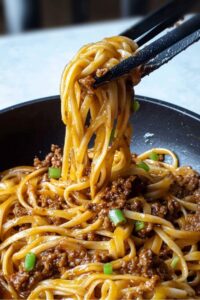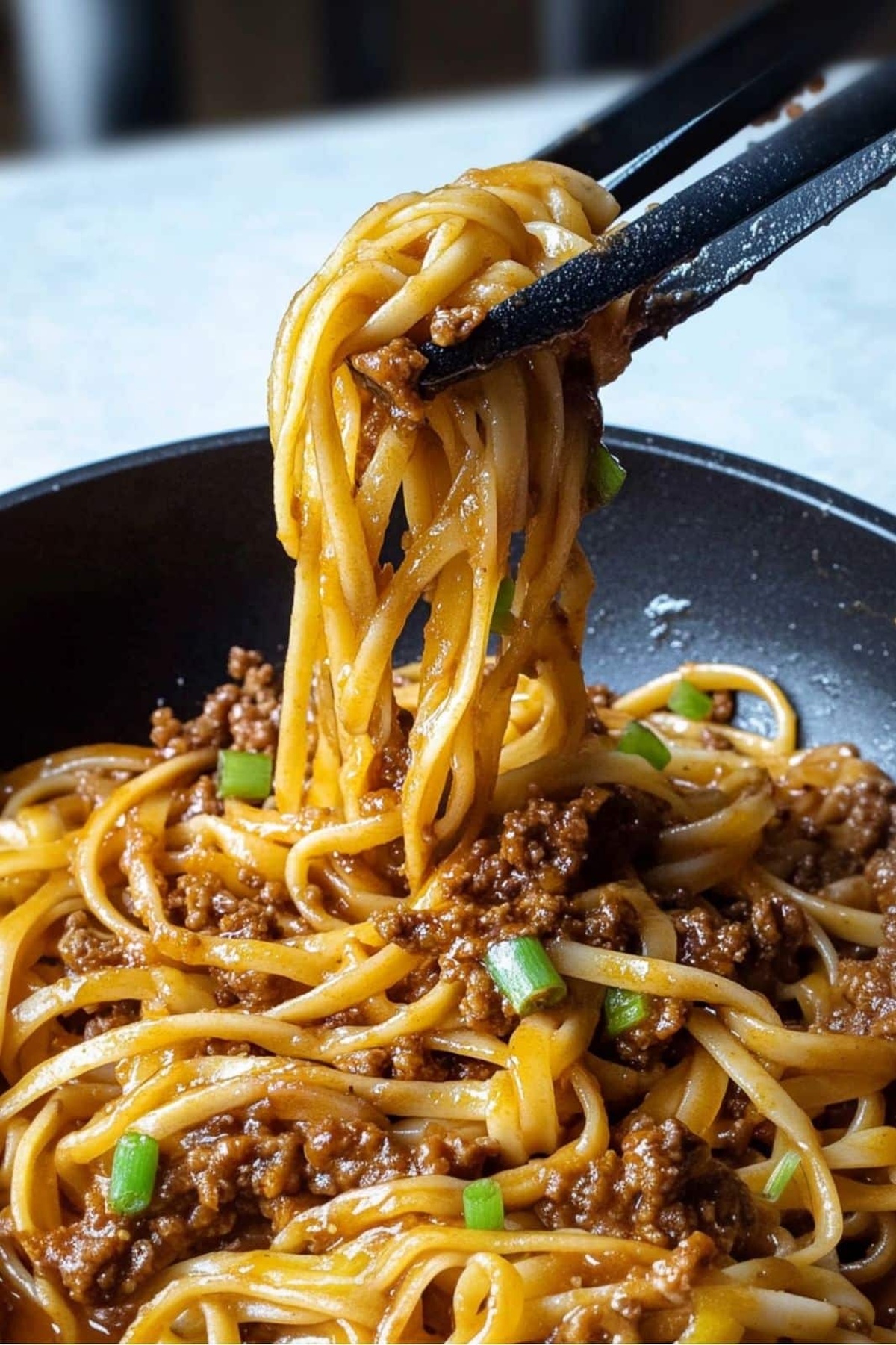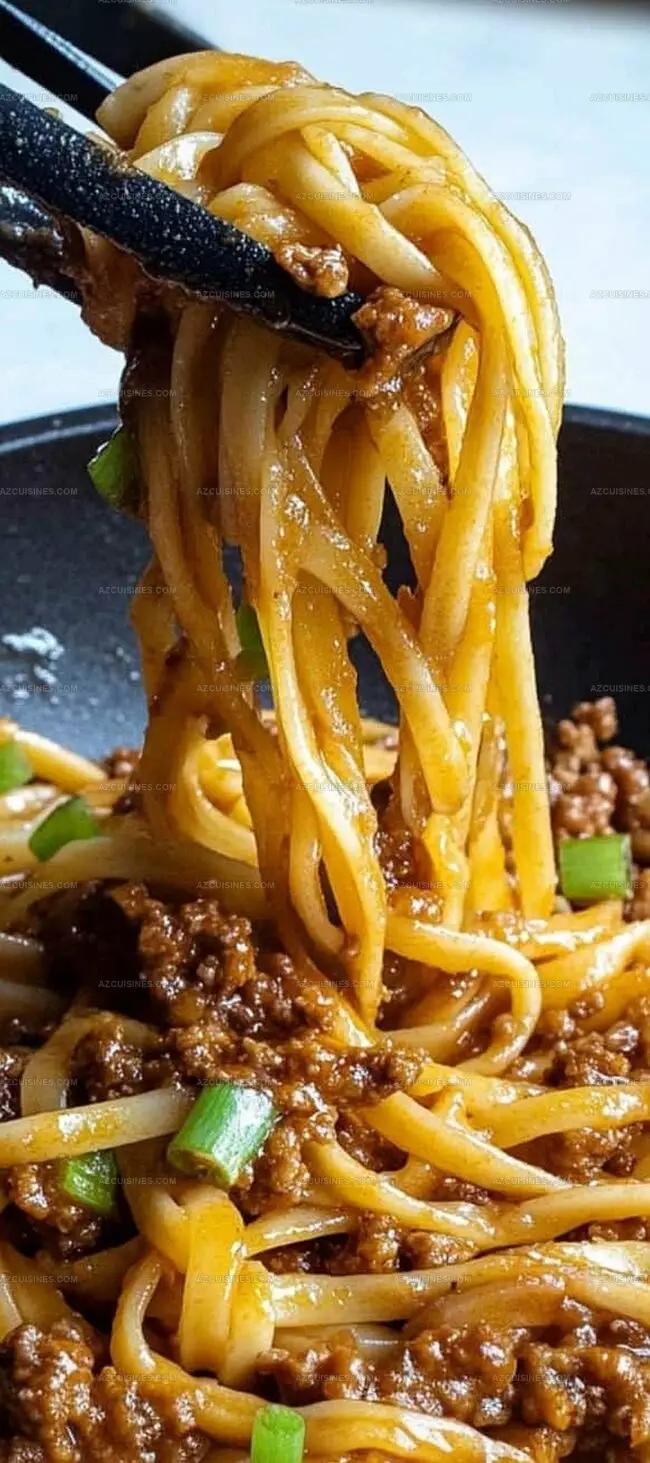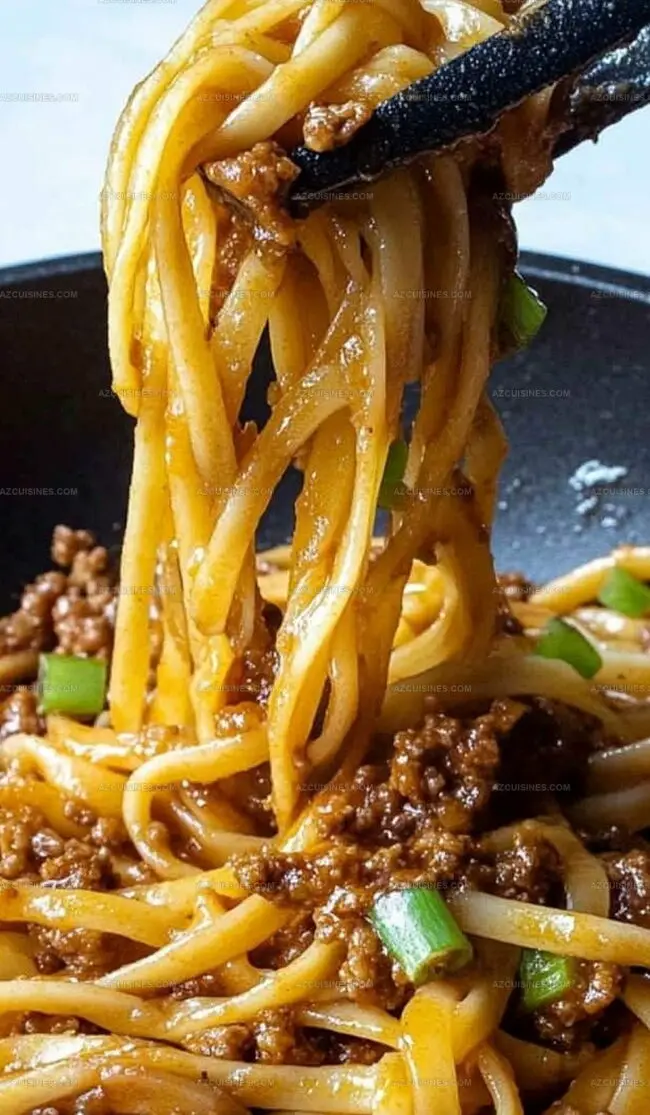Easy Mongolian Ground Beef Noodles Recipe: Sweet & Savory Bliss
Hearty mongolian ground beef noodles dance with bold flavors that spark instant comfort at your dinner table.
Savory spices mingle through tender meat and silky strands, creating a meal that feels like a warm culinary embrace.
Rich umami notes weave through each delectable bite, promising satisfaction in every forkful.
Robust ingredients come together quickly, making this dish perfect for busy nights when hunger strikes.
Regional influences shine through subtle seasonings that elevate simple components into something extraordinary.
Minimal prep work means you can whip up this crowd-pleaser faster than ordering takeout.
Prepare to experience a delicious journey that transforms weeknight cooking into a memorable feast.
Reasons to Love Mongolian Ground Beef Noodles Recipe
Ingredients for Mongolian Ground Beef Noodles Recipe
Pasta Base:Protein:Aromatics and Seasonings:Sauces and Liquids:How to Make Mongolian Ground Beef Noodles Recipe
Step 1: Boil Those Noodles
Cook linguine in a large pot of salted water until perfectly al dente. Drain the noodles and set them aside, ready for their flavor adventure.
Step 2: Sear the Beef
Heat a large skillet over medium-high heat. Toss in the ground beef and break it up while cooking. Let the meat brown beautifully and drain any excess fat for a lean, delicious base.
Step 3: Awaken the Flavors
Add these ingredients to the skillet:Stir everything together and let the aromas dance around the kitchen for about 1 minute.
Step 4: Create the Magic Sauce
In a small bowl, whisk cornstarch with water to make a smooth slurry. Pour this into the skillet and stir continuously until the sauce transforms into a glossy, thick coating.
Step 5: Marry the Noodles and Beef
Tumble the cooked linguine into the skillet. Toss and coat every single noodle with the rich, tantalizing sauce until they’re completely embraced by flavor.
Step 6: Finish with Flair
Sprinkle freshly sliced green onions over the top. Serve immediately while steaming hot and bursting with incredible taste.
Pro Tips for Mongolian Ground Beef Noodles Recipe
Variation Ideas for Mongolian Ground Beef Noodles Recipe
Pairing Suggestions for Mongolian Ground Beef Noodles Recipe
Storage Advice for Mongolian Ground Beef Noodles Recipe
FAQs About Mongolian Ground Beef Noodles Recipe
The heat level depends on personal preference. The recipe includes red pepper flakes, which you can adjust or omit to control spiciness.
Yes, you can substitute linguine with other pasta like spaghetti, egg noodles, or rice noodles based on your preference.
Beef broth adds depth of flavor, but you can replace it with chicken broth or water if needed. The other sauces will still provide good taste.
Substitute hoisin with equal parts soy sauce and brown sugar mixed together, or use barbecue sauce as an alternative to maintain a similar sweet and savory profile.
Print
Mongolian Ground Beef Noodles Recipe
- Total Time: 20 minutes
- Yield: 4 1x
Description
Sizzling Mongolian Ground Beef Noodles deliver bold Asian flavors that dance across your palate with intense umami and spicy undertones. Slick noodles nestled with savory beef create a quick weeknight dinner promising restaurant-quality satisfaction for hungry families.
Ingredients
Main Proteins:
- 1 pound ground beef
- 10 ounces (283 grams) linguine
Seasonings and Sauces:
- 1/3 cup brown sugar
- 1/3 cup soy sauce
- 3 tablespoons hoisin sauce
- 1/4 cup beef broth
- 1 tablespoon cornstarch
- 2 tablespoons water
- 1/2 teaspoon ground ginger
- 1/2 teaspoon ground black pepper
- 1 pinch red pepper flakes
Aromatics and Garnish:
- 5 cloves garlic, minced
- 4 green onions, sliced
Instructions
- Prepare linguine according to package directions at 212°F (boiling water), then drain and reserve.
- Heat large skillet over medium-high heat, cook ground beef until thoroughly browned and no pink remains, approximately 6-8 minutes.
- Eliminate excess beef fat from skillet, then incorporate minced garlic and sauté for 30-45 seconds until aromatic.
- Introduce brown sugar, beef broth, soy sauce, hoisin sauce, ground ginger, black pepper, and red pepper flakes to skillet, stirring thoroughly to distribute seasonings evenly.
- Create cornstarch slurry by whisking water and cornstarch together, then pour into simmering sauce mixture, continuously stirring until sauce transforms and thickens within 2-3 minutes.
- Gently fold cooked linguine into seasoned sauce, ensuring noodles are completely and uniformly coated with rich, flavorful sauce.
- Transfer to serving plates, garnish with thinly sliced green onions, and serve immediately while hot.
Notes
- Enhance flavor by using freshly ground black pepper and grating ginger instead of ground spices for a more vibrant taste profile.
- Make the dish gluten-free by substituting regular soy sauce with tamari and using gluten-free pasta or zucchini noodles.
- Control spice levels by adjusting red pepper flakes – start with a pinch and add gradually to suit personal heat preferences.
- Boost protein content by adding extra vegetables like bell peppers or broccoli for increased nutrition and texture variation.
- Prep Time: 5 minutes
- Cook Time: 15 minutes
- Category: Lunch, Dinner
- Method: Boiling
- Cuisine: Chinese
Nutrition
- Serving Size: 4
- Calories: 655
- Sugar: 15 g
- Sodium: 970 mg
- Fat: 28 g
- Saturated Fat: 11 g
- Unsaturated Fat: 17 g
- Trans Fat: 1 g
- Carbohydrates: 58 g
- Fiber: 3 g
- Protein: 38 g
- Cholesterol: 80 mg




Truc Tran (Kris)
Senior Food Editor
Expertise
Home Cooking, Meal Planning, Recipe Development, Baking and Pastry, Food Editor, Cooking-video Maker, Vietnamese Food Evaluation Expert
Education
Truc Tran (Kris), an experienced food writer and editor, is great at exploring and describing global cuisines, from simple street food to fancy dining. In her writing, she skillfully mixes different flavors, cooking methods, and culinary traditions, showing the unique character of various cultures through their food and drinks. On azcuisines.com, Kris highlights her knowledge, especially in Asian cuisine and worldwide traditional dishes.